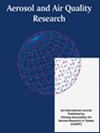从健康角度评价微环境中的超细颗粒和PM2.5:浓度变异性和污染物相互关系
IF 2.5
4区 环境科学与生态学
Q3 ENVIRONMENTAL SCIENCES
引用次数: 1
摘要
法规适用于细颗粒(PM 2.5),但不适用颗粒数浓度(PNC)。我们使用移动平台测量四种微环境(柴油羽流、城市高速公路、城市街道和农村高速公路)中的PNC和PM 2.5。在两年内(2018年冬季和2020年秋季)共使用38661对测量值来评估污染物浓度的变异性及其相互关系。计算和评估来源识别的总PNC (PNC tot)和时间调整的PM 2.5(∆PM 2.5)。结果表明:冬季平均PNC (4.8 × 10.4 pt cm -3)比秋季(0.36 × 10.4 ~ 0.56 × 10.4 pt cm -3)高出2倍以上;此外,在整个研究过程中,交通排放(PNC d,tr)贡献了30%的PNC,而固体燃料燃烧(PNC d,sfb)仅在冬季可能是主要贡献者(29%)。PNC d、tr和PNC d、sfb均存在季节差异,冬季PNC d、tr中值较秋季高2 ~ 3倍,PNC d、sfb中值较秋季高7倍。冬季PM 2.5(109µg m -3)是秋季的3-5倍,∆PM 2.5(40µg m -3)是秋季的3-6倍。冬季,城市街道和农村高速公路的pm2.5和∆PM 2.5浓度较高,与PNC d、sfb相似,但与PNC t、PNC d、tr相反。相关系数(r2)以三种组合(即PNC tot vs. PM 2.5, PNC d,tr vs.∆PM 2.5, PNC d,sfb vs.∆PM 2.5)进行研究。这里的r2表现出与文献相似的季节趋势(冬季低于秋季)和幅度,但没有发现强相关(r2 < 0.15)。这强调了这样一个事实,即pm2.5缓解措施不一定会减少PNC,评估pm2.5暴露的监测网络不太可能代表PNC暴露。三种组合的浓度比随微环境和季节的变化而变化。这种可变性意味着控制政策应该根据城市的污染物类型和能源使用情况而多样化。本文章由计算机程序翻译,如有差异,请以英文原文为准。
Evaluating Ultrafine Particles and PM2.5 in Microenvironments with Health Perspectives: Variability in Concentrations and Pollutant Interrelationships
Regulation has been applied to the fine particles (PM 2.5 ) but not to particle number concentrations (PNC). We use a mobile platform to measure PNC and PM 2.5 in four microenvironments (diesel plume, urban freeway, urban street, and rural freeway). A total of 38661 pairs of measurements in two years (winter 2018 and autumn 2020) are used to evaluate variability in the pollutant concentrations and their interrelationships. Source-discerned total PNC ( PNC tot ) and temporal-adjusted PM 2.5 ( ∆ PM 2.5 ) are calculated and evaluated. Results showed that the average PNC tot in winter (4.8 × 10 4 pt cm –3 ) were over two times higher than autumn (0.36 × 10 4 –0.56 × 10 4 pt cm –3 ). Moreover, the traffic emissions ( PNC d,tr ) contribute 30% of the PNC throughout the study while solid fuel burning ( PNC d,sfb ) could be a major contributor only in winter (29%). Seasonal variability in PNC d,tr and PNC d,sfb was found, with 2–3 times higher median PNC d,tr and 7 times higher median PNC d,sfb in winter compared to autumn. Similarly, PM 2.5 in winter (109 µ g m –3 ) was 3–5 times higher than autumn, while ∆ PM 2.5 (40 µ g m –3 ) was 3–6 times higher. In winter, the PM 2.5 and ∆ PM 2.5 showed higher concentrations in urban street and rural freeway similar to PNC d,sfb but opposite to the trend of PNC tot and PNC d,tr . The correlation coefficient (R 2 ) is investigated as three combinations (i.e., PNC tot vs. PM 2.5 , PNC d,tr vs. ∆ PM 2.5 , PNC d,sfb vs. ∆ PM 2.5 ). Here, the R 2 showed a comparable seasonal trend (winter lower than autumn) and similar magnitude as the literature, but no strong correlation (R 2 < 0.15) was found. This stresses the fact that mitigation measures of PM 2.5 do not necessarily reduce PNC and monitoring networks evaluate PM 2.5 exposure are unlikely to represent PNC exposure. The concentration ratios in the three combinations are found to vary with microenvironments and seasons. This variability implies that control policies should be diversified with pollutant types and energy usage of the city.
求助全文
通过发布文献求助,成功后即可免费获取论文全文。
去求助
来源期刊

Aerosol and Air Quality Research
ENVIRONMENTAL SCIENCES-
CiteScore
8.30
自引率
10.00%
发文量
163
审稿时长
3 months
期刊介绍:
The international journal of Aerosol and Air Quality Research (AAQR) covers all aspects of aerosol science and technology, atmospheric science and air quality related issues. It encompasses a multi-disciplinary field, including:
- Aerosol, air quality, atmospheric chemistry and global change;
- Air toxics (hazardous air pollutants (HAPs), persistent organic pollutants (POPs)) - Sources, control, transport and fate, human exposure;
- Nanoparticle and nanotechnology;
- Sources, combustion, thermal decomposition, emission, properties, behavior, formation, transport, deposition, measurement and analysis;
- Effects on the environments;
- Air quality and human health;
- Bioaerosols;
- Indoor air quality;
- Energy and air pollution;
- Pollution control technologies;
- Invention and improvement of sampling instruments and technologies;
- Optical/radiative properties and remote sensing;
- Carbon dioxide emission, capture, storage and utilization; novel methods for the reduction of carbon dioxide emission;
- Other topics related to aerosol and air quality.
 求助内容:
求助内容: 应助结果提醒方式:
应助结果提醒方式:


